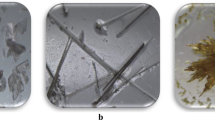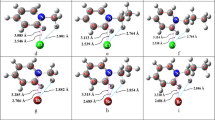Abstract
In this work, six series of new energetic metal complexes were designed. Each complex contained a large, high-energy, high-nitrogen, anionic chelating ligand (either the 5,5′-bistetrazolate anion, the 5,5′-azobistetrazolate anion, or the 5,5′-(hydrazine-1,2-diyl)bis-[1H-tetrazol-1-ide] anion—each of which has a different bridging group), Cu or Ni as the metal atom, and two small complexing agent ligands (NH3 and/or NH2NO2). The molecular and electronic structures, heats of formation, densities, detonation properties, and impact sensitivities of the novel complexes were studied using density functional theory. Furthermore, the effects of varying the large chelating ligand (and thus the bridging group), the small complexing agents, and the metal atom on the structure and properties of the complex were investigated and analyzed in depth. The results show that the particular metal, bridging group, and complexing agents included in the energetic complex influence its structure and properties, but the effects of varying the constituents of the complex are complicated or unclear, and these effects are sometimes intertwined. In addition, the detonation pressures, detonation velocities, and impact sensitivities of the novel complexes ranged from 25.9 to 38.6 GPa, from 7.21 to 8.80 km s−1, and from 17 to 48 cm, respectively. Five of the complexes (B3, C3, D3, E3, and F3) appear to possess comparable performance to the famous and widely used high explosive 1,3,5-trinitro-1,3,5-triazinane, making these new complexes attractive to energetic materials experimentalists.






Similar content being viewed by others
References
Wu Q, Zhu WH, Xiao HM (2014) J Mater Chem A 2:13006–13015
Tsyshevsky R, Pagoria P, Zhang M, Racoveanu A, Parrish DA, Smirnov AS, Kuklja MM (2017) J Phys Chem C 121:23853–23864
Fischer N, Fischer D, Klapötke TM, Piercey DG, Stierstorfer J (2012) J Mater Chem 22:20418–20422
Yin P, Mitchell LA, Parrish DA, Shreeve JNM (2017) Chem-Asian J 12:378–384
Szimhardt N, Bölter MF, Born M, Klapötke TM, Stierstorfer J (2017) Dalton Trans 46:5033–5040
Yin Q, Klare HF, Oestreich M (2016) Angew Chem Int Ed 55:3204–3207
Yin X, Jin X, Xu CX, He P, Wang K, Zhang JG (2016) Cent Eur J Energ Mater 13:301–320
Xu JG, Wang SH, Zhang MJ, Sun C, Xiao Y, Li R (2017) ACS Omega 2:346–352
Cohen A, Yang Y, Yan QL, Shlomovich A, Petrutik N (2016) Chem Mater 28:6118–6126
Xu Y, Wang Q, Shen C, Lin C, Wang P, Lu M (2017) Nature 549:78–81
Wu Q, Kou B, Zhang Z, Hang Z, Zhu W (2017) J Mol Model 23:254
Gao H, Huang Y, Twamley B, Ye C, Shreeve JM (2008) ChemSusChem 1:222–227
Guo Y, Tao GH, Zeng Z, Gao H, Parrish DA, Shreeve JM (2010) Chem Eur J 16:3753–3762
Guo Y, Gao H, Twamley B, Shreeve JM (2007) Adv Mater 19:2884–2888
Klapötke TM, Sabaté CM (2007) Z Anorg Allg Chem 633:2671–2677
Tao GH, Twamley B, Shreeve JM (2009) Inorg Chem 48:9918–9923
Ebespächer M, Klapötke TM, Sabaté CM (2009) New J Chem 33:517–527
Karaghiosoff K, Klapötke TM Sabaté CM (2009) Eur J Inorg Chem 238–250
Shu Y, Li H, Gao S, Xiong Y (2013) J Mol Model 19:1583–1590
Tao JM, Perdew JP, Starroverov VN, Scuseria GE (2003) Phys Rev Lett 91:146401
Rydberg P, Olsen L (2009) J Phys Chem A 113:1949–1953
Rayon VM, Valdes H, Diaz N, Suarez D (2008) J Chem Theory Comput 4:243–256
Sharma P, Singh HJ, Sengupta SK (2016) J Chem Sci 128:1923–1932
Frisch MJ, Trucks GW, Schlegel HB, Scuseria GE, Robb MA, Cheeseman JR, Zakrzewski VG, Montgomery JA, Stratmann RE, Burant JC, Dapprich S, Millam JM, Daniels AD, Kudin KN, Strain MC, Farkas O, Tomasi J, Barone V, Cossi M, Cammi R, Mennucci B, Pomelli C, Adamo C, Clifford S, Ochterski J, Petersson GA, Ayala PY, Cui Q, Morokuma K, Malick DK, Rabuck AD, Raghavachari K, Foresman JB, Cioslowski J, Ortiz JV, Baboul AG, Stefanov BB, Liu G, Liashenko, A, Piskorz P, Komaromi I, Gomperts R, Martin RL, Fox DJ, Keith T, Al-Laham MA, Peng CY, Nanayakkara A, Gonzalez C, Challacombe M, Gill PMW, Johnson B, Chen W, Wong MW, Andres JL, Gonzalez C, Head-Gordon M, Replogle ES, Pople JA (2009) Gaussian 09, revision A 01. Gaussian, Inc., Wallingford
Kamlet MJ, Jacobs S (1968) J Chem Phys 48:23–35
Wang Y, Zhang JC, Su H, Li SH, Zhang SW, Pang SP (2014) J Phys Chem A 118:4575–4581
Politzer P, Martinez J, Murray JS, Concha MC, Toro-Labbé A (2009) Mol Phys 107:2095–2101
Pospíšil M, Vávra P, Koncha MC, Murray JS, Politzer P (2010) J Mol Model 16:895–901
Ghule VD, Jadhav PM, Patil RS, Radhakrishnan S, Soman T (2010) J Phys Chem A 114:498
Astakhov AM, Stepanov RS, Babushkin AY (1998) Combust Explo Shock+ 34: 85
Wu Q, Zhu WH, Xiao HM (2014) RSC Adv 4:3789–3797
Trzciński WA, Cudziło S, Chyłek Z, Szymańczyk L (2008) J Hazard Mater 157:605–612
Politzer P, Murray JS (2014) J Mol Model 20:2223–2230
Politzer P, Murray JS (2015) J Mol Model 21:262
Politzer P, Murray JS (2015) J Mol Model 21:25
Politzer P, Murray JS (2016) Propellants Explos Pyrotech 41:414–425
Pan Y, Zhu WH (2017) J Phys Chem A 121:9163–9171
Rice BM, Hare JJ (2002) Phys J Chem A 106:1770–1783
Acknowledgments
The present work was supported by the Natural Science Foundation of Nanjing Institute of Technology (CKJA201603, ZKJ201501), the Natural Science Foundation of Jiangsu (BK20170761, BK20160773), the National Natural Science Foundation of China (NSFC21603102), the Jiangsu Key Laboratory Opening Project of Advanced Structural Materials and Application Technology (ASMA201707), and the Outstanding Scientific and Technological Innovation Team in Colleges and Universities of Jiangsu Province.
Funding
The authors declare no competing financial interest.
Author information
Authors and Affiliations
Corresponding author
Rights and permissions
About this article
Cite this article
Wu, Q., Zhang, Z., Kou, B. et al. A DFT study of the structure–property relationships of bistetrazole-based high-nitrogen energetic metal complexes. J Mol Model 24, 119 (2018). https://doi.org/10.1007/s00894-018-3658-z
Received:
Accepted:
Published:
DOI: https://doi.org/10.1007/s00894-018-3658-z




